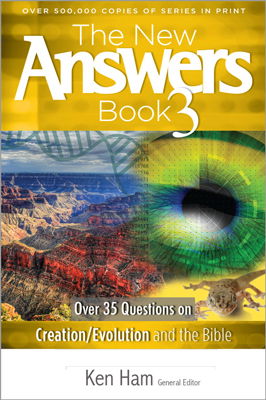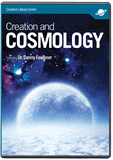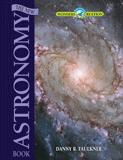
Chapter 21
What About Cosmology?
Since the late 1960s, the dominant cosmology has been the big-bang model.
Since the late 1960s, the dominant cosmology has been the big-bang model. The
big bang is a hypothetical event in which the universe suddenly appeared 13.71
billion years ago. Initially much smaller, denser, and hotter, the universe
expanded and cooled to the one that we see today. The big-bang theory is a radical
departure from more than two millennia of thinking on cosmology, for since ancient
times many Western scientists and philosophers had assumed that the universe
was eternal. It ought to be obvious that an eternal universe does not square
with Genesis 1:1, which declares that “in the beginning God created the heavens
and the earth
,” collectively referring to the creation of all that exists in
the physical world.
Many Christians have embraced the big-bang cosmology, distilling the theory down to the fact that the big bang represents a beginning of the universe, apparently in some concordance with Genesis 1:1. However, closer examination reveals that the big bang does not agree with the details of the biblical creation account at all.
Big Bang Background
Before delving into that, we ought to mention a little background on the big-bang model. The big-bang model relies upon the expansion of the universe, first confirmed by Edwin Hubble in 1928. The expansion of the universe had been predicted by Einstein’s theory of gravity, general relativity, more than a decade earlier. Einstein had realized the implication of an expanding universe possibly requiring a beginning, so he introduced the cosmological constant into his solution of the universe to produce a cosmology that was not expanding, and hence could exist eternally.
This static universe was no longer tenable once Hubble showed that the universe was expanding.
This static universe was no longer tenable once Hubble showed that the universe was expanding. However, proponents of an eternal universe did not give in. Prior to 1965, the most popular cosmology was the steady state theory. The steady state model acknowledges that expansion occurs, but hypothesizes that as the universe expands, more matter spontaneously comes into existence to preserve a constant density.
This steady state model is eternal—without beginning and without end. The steady state model had tremendous philosophical appeal well into the 1960s as people had difficulty thinking about the universe in any other way than being eternal. All this changed with the 1965 discovery of the cosmic microwave background (CMB), a low-level, nearly uniform radiation permeating the universe from all directions. Since the CMB had been predicted by the big-bang model as early as 1948, and the steady state theory could not account for the CMB, most scientists adopted the big-bang model shortly after 1965.
Variations on the steady state model have not entirely gone away—there are a few adherents around today. A notable variation of the steady state theory today is plasma cosmology. However, the big-bang theory is so dominant today that these steady state variations are virtually irrelevant, so we will concentrate on the big-bang model.
Genesis and the Big Bang
As previously mentioned, some Christians adopt the big-bang model as part of their apologetic. If the universe had a beginning in agreement with the creation account, then they reason that this offers a tool to somehow prove that the Bible is true. Since the modern big-bang model hypothesizes that the universe began 13.71 billion years ago, belief in the big bang requires belief in a universe much older than the few thousand years calculated from the Old Testament chronologies. How do people reconcile this colossal difference?
The gap theory, day-age theories, allegory, and the framework hypothesis are all different ways that people have attempted to reconcile the discrepancy. All of these attempts have been discussed elsewhere, but suffice it to say here that each poorly handles Scripture. And these solutions raise thorny questions as well. What is the origin of sin? What is the penalty of sin? Did death precede the Fall of mankind? While many old-age creationists attempt to hold onto some semblance of orthodoxy on these questions, regrettably many do not, opting to allegorize much of the first few chapters of Genesis.
Other Issues
But there are other problems as well. For instance, the big-bang model posits that stars and galaxies formed within a billion years of the beginning of the universe, and that star formation continues today. Since the solar system is supposedly 4.6 billion years old, this would mean at least eight billion years of star formation preceded the creation of the earth. However, the Genesis 1 text tells us that earth preceded the stars; the earth was made on Day One and the stars on Day Four. Furthermore, in no way could one say that the creation has been completed if it is an ongoing process now.
Astronomers generally agree that some unknown mechanism triggered star formation at a prodigious rate.
The naturalistic origin of stars itself is a problem. Astronomers have theories of how stars form, but each one requires that stars first exist. Current cosmological theories suggest that star formation in the early universe was very intense, with stars forming at a rate many orders of magnitude faster than today. How this came about is unknown. Astronomers generally agree that some unknown mechanism triggered star formation at a prodigious rate. Is this science?
With the largest telescopes we can see distant galaxies that presumably formed in the early universe, and hence are very young. We see that these distant galaxies have the same structure that nearby, supposedly much older, galaxies have. However, physics would seem to dictate that galaxies change with age, but this does not appear to be the case in a big-bang universe.
Additionally, the big-bang model requires that the universe begin with all matter in the universe in the form of hydrogen and helium (and a trifling bit of lithium). All other heavier elements, such as oxygen, calcium, and iron, were gradually forged through nucleosynthesis in later generations of stars. However, the spectra of distant (and supposedly younger) galaxies are rich in heavier elements. This would seem to violate a basic tenet of the big-bang model, instead allowing for heavier elements to exist from the beginning.
An Evolving Model
The big-bang model itself has undergone quite an evolution since its widespread acceptance. It is interesting to compare the big-bang model at the time of the writing of this chapter, 2009, to the big-bang model of 1984, just 25 years earlier. From about 1960 to the early 1990s, the best measure of the expansion rate of the universe (the Hubble constant) was about 50 km/s/Mpc (kilometers per second per megaparsec). In the early 1990s, that rate was increased to nearly 80 km/s/Mpc. Around 1980 some astronomers had attempted to raise the Hubble constant to nearly 100 km/s/Mpc, but their work was largely rejected at the time as most astronomers thought that the lower value was firmly established.
Of course, now astronomers think that the higher value is firmly established. With a faster expansion rate, the inferred age of the universe has diminished. With the earlier value of the Hubble constant, the age was solidly thought to be 16–18 billion years old. Now cosmologists think that the universe is 13.71 billion years, give or take 1 percent. Notice that the error bars on those two figures do not overlap, so they both cannot be correct.
Several physical effects now taken as a given in big-bang models were not largely accepted in 1984. One example is inflation, first proposed by Alan Guth in 1980. Inflation was invoked to explain several problems with the big bang, such as the flatness and horizon problems. While inflationary big-bang models were being developed in 1984, these models were not widely accepted until a few years later. Other effects include string theory, dark matter, and dark energy.
Among theoretical physicists, string theory is the current explanation of how elementary particles of matter work. String theory is the idea that elementary particles are a sort of vibration in at least six additional dimensions of space. These six dimensions occur in two sets of three each. Today, these additional dimensions are rolled up beyond our ability to detect them, but in the hot cauldron of the early big bang the high temperatures would have made these extra dimensions manifest. So any serious big-bang model now must incorporate them, though in 1984 few, if any, models did. Dark matter is a mysterious substance that reveals itself by its gravitational influence. While dark matter was first proposed in the 1930s, good data to support it began to arise in the 1970s. Yet dark matter generally was not included in big-bang models of 1984.
Finally in 1999, an extensive study combined data from several different programs to produce what was then the definitive description of some parameters of the big bang. Much to the amazement of all, the data showed what appeared to be an increase in the rate of expansion of the universe. Normally, gravity ought to be sufficient to rein in expansion, but this effect was as if space were repelling itself. This effect is very similar to Einstein’s cosmological constant, though the re-christened “dark energy” was intentionally named to underscore the more modern approach to how such a thing might happen. We ought to add that some of these effects, such as string theory and inflation, have no data to support them—they are included only because theoretical physicists and cosmologists think that they describe the way the world works.
We have no idea what the big-bang model will be like 25 years hence, but we can be certain of two things: the model will be very different then from now, and cosmologists will have complete confidence in that model.
So let us compare the big-bang model of today and 25 years earlier. Then, the expansion rate and hence the inferred age of the universe were remarkably different from the rate and age today. Then, there was no inflation, while today one would not think of leaving inflation out of a big-bang model. Then, string theory had not yet been developed, but now it must be included in a big-bang model. Then, dark matter, though known, was not included in cosmological models, but today it is a must to include it. Einstein’s cosmological constant was thrown out by 1930, but it came roaring back 70 years later to be included in today’s model.
In short, the big-bang model of 25 years ago bears almost no resemblance to the big-bang model of today. How confident of the big-bang model were cosmologists 25 years ago? They had complete confidence. How confident are today’s cosmologists of the current big-bang model? They have complete confidence. If cosmologists were right then, they cannot be right today; if cosmologists are right today, they could not have been right 25 years ago. We have no idea what the big-bang model will be like 25 years hence, but we can be certain of two things: the model will be very different then from now, and cosmologists will have complete confidence in that model.
Some of these changes to the big-bang model were driven by changes in theoretical physics, as with string theory. Others were driven by new data, such as dark energy and a revised expansion rate and age. However, some, such as inflation, were invoked merely to salvage the big-bang model. This reveals a deep philosophical problem with the big-bang model. The model has become very plastic. That is, any unexpected new observation or problem can be solved by the appropriate addition of some new effect or some new field.
Some view this as constraining the model and providing physical rigor, but at some point one has to question whether the big-bang model is falsifiable. That is, is there some new result or data that could disprove the model? It would appear that with proper corrections to the model allowed, this will never happen. If this indeed is the situation, then is the big-bang model a scientific model in any way?
Nearly two millennia ago, Claudius Ptolemy published his famous geocentric model of the solar system with planets moving along epicycles that in turn orbited about the earth. In terms of longevity, the Ptolemaic model is the most successful scientific theory of all time, lasting 15 centuries. Throughout the middle ages, scientists found that when the theory did not match observations, they could fix the problem by adding additional epicycles. Unlimited modification allowed for the model to explain everything and anything that happened to arise.
Ultimately, most people realized that the Ptolemaic model became far too complex for its own good, and it collapsed under its own weight in favor of the much simpler heliocentric model. A model that can explain anything and everything is not a good theory. The big-bang model has already demonstrated that it, too, can endure modification ad infinitum. At some point we must question whether the big-bang model really is a good theory in the sense that it could be falsified by some new hypothetical result.
Conclusion
The history of science is filled with examples of theories once thought to be unassailable but later discarded. If the history of science is any teacher, then we would expect that the big bang will also be discarded. If we have wedded our apologetic to the big-bang model, then the rejection of the big-bang model will logically lead to the rejection of our apologetic. Many in the Roman Catholic Church four centuries ago embraced the Ptolemaic model, attempting to make it part of Christianity, and it brought discredit to them and their church when that model fell. Those who wish to make the big bang part of the biblical creation model ought to take this lesson to heart. More importantly, the big bang (in any of its versions) is not compatible with a natural reading of the Bible. The Christian should have confidence that God’s Word is reliable, regardless of whether it is fashionable for fallible men to agree.
The New Answers Book 3
Do you have answers to the big questions about the Christian faith, evolution, creation, and the biblical worldview? Now you get the important information you need regarding the existence of God, global warming and climate change, cloning and stem cells, human and chimp DNA, the importance of Mount St. Helens, and more.
Read Online Buy BookRecommended Resources

Answers in Genesis is an apologetics ministry, dedicated to helping Christians defend their faith and proclaim the good news of Jesus Christ.
- Customer Service 800.778.3390
- © 2024 Answers in Genesis






